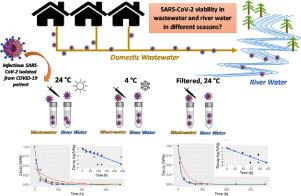Water Research ( IF 12.8 ) Pub Date : 2021-03-03 , DOI: 10.1016/j.watres.2021.117002 Leonardo Camilo de Oliveira 1 , Andrés Felipe Torres-Franco 2 , Bruna Coelho Lopes 2 , Beatriz Senra Álvares da Silva Santos 3 , Erica Azevedo Costa 3 , Michelle S Costa 4 , Marcus Tulius P Reis 5 , Marília C Melo 6 , Rodrigo Bicalho Polizzi 7 , Mauro Martins Teixeira 1 , César Rossas Mota 2

|
COVID-19 patients can excrete viable SARS-CoV-2 virus via urine and faeces, which has raised concerns over the possibility of COVID-19 transmission via aerosolized contaminated water or via the faecal-oral route. These concerns are especially exacerbated in many low- and middle-income countries, where untreated sewage is frequently discharged to surface waters. SARS-CoV-2 RNA has been detected in river water (RW) and raw wastewater (WW) samples. However, little is known about SARS-CoV-2 viability in these environmental matrices. Determining the persistence of SARS-CoV-2 in water under different environmental conditions is of great importance for basic assumptions in quantitative microbial risk assessment (QMRA). In this study, the persistence of SARS-CoV-2 was assessed using plaque assays following spiking of RW and WW samples with infectious SARS-CoV-2 that was previously isolated from a COVID-19 patient. These assays were carried out on autoclaved RW and WW samples, filtered (0.22 µm) and unfiltered, at 4 °C and 24 °C. Linear and nonlinear regression models were adjusted to the data. The Weibull regression model achieved the lowest root mean square error (RMSE) and was hence chosen to estimate T90 and T99 (time required for 1 log and 2 log reductions, respectively). SARS-CoV-2 remained viable longer in filtered compared with unfiltered samples. RW and WW showed T90 values of 1.9 and 1.2 day and T99 values of 6.4 and 4.0 days, respectively. When samples were filtered through 0.22 µm pore size membranes, T90 values increased to 3.3 and 1.5 days, and T99 increased to 8.5 and 4.5 days, for RW and WW samples, respectively. Remarkable increases in SARS-CoV-2 persistence were observed in assays at 4 °C, which showed T90 values of 7.7 and 5.5 days, and T99 values of 18.7 and 17.5 days for RW and WW, respectively. These results highlight the variability of SARS-CoV-2 persistence in water and wastewater matrices and can be highly relevant to efforts aimed at quantifying water-related risks, which could be valuable for understanding and controlling the pandemic.
中文翻译:

不同温度和固体含量下 SARS-CoV-2 在河水和废水中的生存能力
COVID-19 患者可以通过尿液和粪便排出活的 SARS-CoV-2 病毒,这引起了人们对 COVID-19 通过雾化污染水或通过粪口途径传播的可能性的担忧。这些担忧在许多低收入和中等收入国家尤为严重,在这些国家,未经处理的污水经常被排放到地表水中。已在河水 (RW) 和原废水 (WW) 样本中检测到 SARS-CoV-2 RNA。然而,人们对 SARS-CoV-2 在这些环境基质中的生存能力知之甚少。确定 SARS-CoV-2 在不同环境条件下在水中的持久性对于定量微生物风险评估 (QMRA) 的基本假设非常重要。在这项研究中,在 RW 和 WW 样本中加入先前从 COVID-19 患者身上分离出的传染性 SARS-CoV-2 后,使用斑块测定评估了 SARS-CoV-2 的持久性。这些测定是在 4 °C 和 24 °C 下对高压灭菌的 RW 和 WW 样品进行的,过滤(0.22 µm)和未过滤。根据数据调整线性和非线性回归模型。Weibull 回归模型实现了最低的均方根误差 (RMSE),因此被选择用于估计 T90和 T 99(分别减少 1 个对数和 2 个对数所需的时间)。与未过滤的样本相比,SARS-CoV-2 在过滤后的存活时间更长。RW 和 WW 分别显示1.9 天和 1.2 天的T 90值和 6.4 天和 4.0 天的 T 99值。当样品通过孔径为 0.22 µm 的膜过滤时,RW 和 WW 样品的 T 90值分别增加到 3.3 和 1.5 天,T 99增加到 8.5 和 4.5 天。在 4 °C 的测定中观察到 SARS-CoV-2 持久性显着增加,显示 T 90值为 7.7 和 5.5 天,T 99RW 和 WW 的值分别为 18.7 天和 17.5 天。这些结果突出了 SARS-CoV-2 在水和废水基质中持久性的可变性,并且可能与旨在量化与水相关的风险的工作高度相关,这对于理解和控制大流行可能很有价值。


























 京公网安备 11010802027423号
京公网安备 11010802027423号